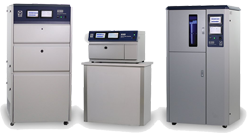耐候性试验
Weathering Testing
咨询热线
18566398802ASTM G167-2015
ASTM G167-2015标准介绍
ASTM G167-2015发行信息
标准号ASTM G167-2015
中文名 用直接日射强度表校正日射强度计的标准试验方法
英文名Standard Test Method for Calibration of a Pyranometer Using a Pyrheliometer
发布日期2015
实施日期
废止日期无
国际标准分类号07.060
发布单位US-ASTM
ASTM G167-2015适用范围
1.1 This test method covers an integration of previous Test Method E913 dealing with the calibration of pyranometers with axis vertical and previous Test Method E941 on calibration of pyranometers with axis tilted. This amalgamation of the two methods essentially harmonizes the methodology with ISO 9846.
1.2 This test method is applicable to all pyranometers regardless of the radiation receptor employed, and is applicable to pyranometers in horizontal as well as tilted positions.
1.3 This test method is mandatory for the calibration of all secondary standard pyranometers as defined by the World Meteorological Organization (WMO) and ISO 9060, and for any pyranometer used as a reference pyranometer in the transfer of calibration using Test Method E842.
1.4 Two types of calibrations are covered: Type I calibrations employ a self-calibrating, absolute pyrheliometer, and Type II calibrations employ a secondary reference pyrheliometer as the reference standard (secondary reference pyrheliometers are defined by WMO and ISO 9060).
1.5 Calibrations of reference pyranometers may be performed by a method that makes use of either an altazimuth or equatorial tracking mount in which the axis of the radiometer's radiation receptor is aligned with the sun during the shading disk test.
1.6 The determination of the dependence of the calibration factor (calibration function) on variable parameters is called characterization. The characterization of pyranometers is not specifically covered by this method.
1.7 This test method is applicable only to calibration procedures using the sun as the light source.
1.8 This standard does not purport to address all of the safety concerns, if any, associated with its use. It is the responsibility of the user of this standard to establish appropriate safety and health practices and determine the applicability of regulatory limitations prior to use.
1.1本试验方法涵盖了先前关于轴垂直日射强度计校准的试验方法E913和先前关于轴倾斜日射强度计校准的试验方法E941的集成。这两种方法的融合基本上使该方法与ISO 9846相协调。
1.2本试验方法适用于所有日射强度计,无论采用何种辐射受体,也适用于水平和倾斜位置的日射强度计。
1.3本试验方法对于校准世界气象组织(WMO)和ISO 9060规定的所有二级标准日射强度计,以及使用试验方法E842进行校准时用作参考日射强度计的任何日射强度计是强制性的。
1.4包括两种类型的校准:I型校准采用自校准绝对日射强度计,II型校准采用二次参考日射强度计作为参考标准(二次参考日射强度计由WMO和ISO 9060定义)。
1.5参考日射强度计的校准可通过使用altazimuth或赤道跟踪装置的方法进行,其中辐射计辐射受体的轴在遮光盘试验期间与太阳对齐。
1.6确定校准因子(校准函数)对可变参数的依赖性称为表征。日射强度计的特性不包括在本方法中。
1.7本试验方法仅适用于使用太阳作为光源的校准程序。
1.8本标准并非旨在解决与其使用相关的所有安全问题(如有)。本标准的使用者有责任在使用前建立适当的安全和健康实践,并确定监管限制的适用性。
4.1The pyranometer is a radiometer designed to measure the sum of directly solar radiation and sky radiation in such proportions as solar altitude, atmospheric conditions and cloud cover may produce. When tilted to the equator, by an angle x03b2;, pyranometers measure only hemispherical radiation falling in the plane of the radiation receptor.
4.2This test method represents the only practical means for calibration of a reference pyranometer. While the sun-trackers, the shading disk, the number of instantaneous readings, and the electronic display equipment used will vary from laboratory to laboratory, the method provides for the minimum acceptable conditions, procedures and techniques required.
4.3While, in theory, the choice of tilt angle (x03b2;) is unlimited, in practice, satisfactory precision is achieved over a range of tilt angles close to the zenith angles used in the field.
4.4The at-tilt calibration as performed in the tilted position relates to a specific tilted position and in this position requires no tilt correction. However, a tilt correction may be required to relate the calibration to other orientations, including axis vertical.
NOTE 1:WMO High Quality pyranometers generally exhibit tilt errors of less than 0.58201;%. Tilt error is the percentage deviation from the responsivity at 0x00b0; tilt (horizontal) due to change in tilt from 0x00b0; to 90x00b0; at 1000 Wx00b7;m23.
4.5Traceability of calibrations to the World Radiometric Reference (WRR) is achieved through comparison to a reference absolute pyrheliometer that is itself traceable to the WRR through one of the following:
4.5.1One of the International Pyrheliometric Comparisons (IPC) held in Davos, Switzerland since 1980 (IPC IV). See Refs (3-7).
4.5.2Any like intercomparison held in the United States, Canada or Mexico and sanctioned by the World Meteorological Organization as a Regional Intercomparison of Absolute Cavity Pyrheliometers.
4.5.3Intercomparison with any absolute cavity pyrheliometer that has participated in either and IPC or a WMO-sanctioned intercomparison within the past five years and which was found to be within x00b1;0.48201;% of the mean of all absolute pyrheliometers participating therein.
4.6The calibration method employed in this test method assumes that the accuracy of the values obtained are independent of time of year, with the constraints imposed and by the test instrument's temperature compensation circuit (neglecting cosine errors).
温馨提醒:本ASTM G167-2015可能存在更新的版本,建议寻找ASTM G167-2015的发行商确认。

 粤公网安备 44060402000067号
粤公网安备 44060402000067号